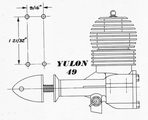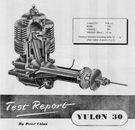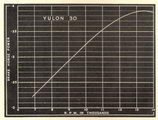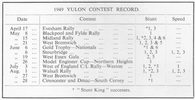Yulon 29
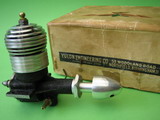 |
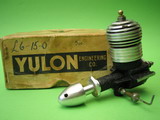 |
Click on images to view larger picture.
The British Yulon can be described in two words: desirable, and loud! According to Fisher, the first really good English glow engine was the original Yulon, produced by Messrs Yule and Long (you can see where the name came from), of Birmingham. It featured 360° porting achieved simply by drilling a series of tiny holes around the cylinder; one row for exhaust, another for transfer. As this arrangement means that the exhaust must fully open before transfer can start, it becomes necessary to open the exhaust early to get a reasonable transfer duration, contributing to a high exhaust velocity and hence the much beloved racket it produced. The crankcase on all but the last product, the Yulon Eagle, sported a distinctive black crackle finish, a good way to hide the raw casting finish, although that on the Yulon in the photos does no seem to be awful.
The Yulon did not remain in production very long, although they did produce enough models and marks during that time to make collecting a full set quite a task. Starting with the .30, which featured the distinctive layer cake head, they added a .29 and a .49, the latter being a scaled up .29. The last Yulon, the "Eagle" abandoned the drilled ports (which made quite a sight on dusk, so I'm told) for more conventional slit ports and for the first time, a round rather than hex stock prop driver. All featured "up-draft" FRV inlet porting.
The following text, by a young Peter Chinn, appeared in Model Planes Annual for 1950. The air-brush cut-away has a few strange proportions, but does give a good idea how how the engine went together.
ONE of the highlights of the 1949 competition season has been the outstanding performance of stunt models powered with the new British Yulon 30 glo-plug engine. Commencing with the Evesham Rally on April 17th, and in the space of five months, the Yulon has piled up an impressive list of contest successes which, in addition to the two most important trophies, the old and Model Engineer cups, has included first places at the Blackpool and Fylde Rally, the Midland Rally at West Bromwich, Stourbridge, the Weston Rally, the Walsall Rally and many other stunt contests too numerous to mention, plus a first in speed at the Weston Rally and 1-2-3 placings in speed events at Stourbridge and Walsall.
Altogether, a fine start for an entirely new product, the introduction of which had been heralded with considerably less than the usual publicity and which has thus gained recognition in the most meritorious way.
The Yulon is an unusual engine in many respects. Perhaps its most outstanding feature is the very light weight which has been achieved-only 51 ounces-for a swept volume of 5 C.c. This, combined with a high output, gives the Yulon an exceptional power-weight ratio, a quality which is, of course, highly desirable to meet modern ideas of stunt model design.
Another noteworthy feature is the porting system employed, this being, in effect, a modified version of the 360 degree layout first used by Arden and now found on many small high performance motors. In the Yulon, the exhaust consists of a ring of twenty-four small circular ports while a true 360 degree transfer passage is employed with cylinder ports drilled below the exhaust ports in place of the transfer grooves more commonly used with annular porting systems. Induction is through a shaft type rotary valve and short intake tube below the main bearing which contributes to the short bearer length necessary or, alternatively, allows the three-point radial mounting studs to be used for direct fixing to a front bulkhead.
The writer has had a Yulon in use for six months past and only when the engine was installed in a model (in this case a "Super-Looper") did its true worth become really apparent. Such a combination as this, because of the low power loading obtained which will allow the model to go through any maneuver at high speed and without hesitation, can actually be safer to fly than one of the slower types of stunter which were being used a year or two ago. Despite its light weight, however, the Yulon appears to be well able to withstand all the usual knocks which a stunt model gets and although, on one occasion, a 60 m.p.h. plus crash with the" SuperLooper" broke the bearers away from the fuselage, the engine came through unscathed.
This particular engine was tested to determine power output after a nominal running-in period of two hours. More recently, having completed about four hours, a further check was made on the power being developed and the results of this are shown in the accompanying graph.
It will be seen that the output is now 0.39 b.h.p. at 13,500 r.p.m., a very good performance indeed. Record-Powerplus racing fuel, which is a nitroparaffin content alcohol/castor blend and is now recommended by the makers, was used and atmospheric conditions can be considered normal, relative humidity being about 70 per cent with the thermometer reading 75 degrees F. From these performance figures, a power to weight ratio exceeding 1.13 b.h.p./lb. is obtained.
For the purpose of this report, a new Yulon engine was obtained from a retailer's stock and its performance checked against that which had been previously obtained from the older engine. The figures showed unusual consistency, the maximum discrepancy in speed recorded up to 11,000 r.p.m. being to the order of 2 per cent. in favour of the new engine. This engine had the normal open type jet which is now being fitted to the Yulon in place of the spray bar type needle-valve assembly with which earlier models were equipped. This allows a larger intake area and may be responsible for an even higher output eventually being reached.
The Yulon starts easily. The normal procedure employed by the writer is to choke the engine for two or three flicks and, when starting from cold, to prime through the exhaust port. Little or no re-adjustment of the needle-valve is necessary when the engine is suitably loaded and, when warm, the motor can be re-started without further priming.
In fact, by locating the tank so as to give a slight gravity feed when full, the new engine, using the open type needle-valve, was found to start under all conditions simply by choking the intake and without recourse to priming through the ports even when starting up for the first time.
Apart from the different type of jet fitted, Yulons now being produced have a slightly higher compression-ratio than the earlier engines with the result that, on ordinary straight methanol-castor mixture, firing is much smoother at reduced revs while starting is, if anything, easier than before. Actually, of course, there is little occasion to run an engine of this type at less than 8,000 revs or so; but, for those who wish to experiment, the ignition timing of a glo-plug engine can be adjusted within limits by "winkling" the glo-plug i.e., pushing in or pulling out the element very slightly. For all normal purposes, however, the plug is best left alone. Few engines are hard on plugs if properly treated and it may be mentioned that, in the case of the K.L.G. plug fitted to the Yulon, the writer has yet to experience a burnt-out element. By avoiding the use of more than the minimum voltage required to start and by wiring the plug to convenient terminals on the fuselage of the model (do not use crocodile-clips on the plug terminal itself since vibration will loosen the central electrode and ruin the element in a short time), much can be done towards prolonging the life of glo-plugs.
The Yulon crankcase is diecast in DTD.424 alloy and has detachable rear cover. Three studs are provided which replace the rear cover screws to enable a bulkhead type mounting to be used, if desired, in place of the normal beam mount.
The cylinder-liner is of Meehanite, honed and lapped, as is the piston. A one-piece cylinder barrel and head is threaded on to the liner and is machined from low-expansion aluminium alloy. Crankshaft is of Durachrome on silver steel and a light alloy connecting-rod is used. The gudgeon-pin is of silver steel. Plain bearings are used throughout.
To summarize, the Yulon 30 is essentially a high-speed engine, possessing an exceptional power-weight ratio and is well suited to stunt and speed control line models and to high-performance free flight models of the larger power-duration type. There is little doubt that, for a stunt model of around 300 sq. in. wing area, few engines, British or American, are able to equal the Yulon.
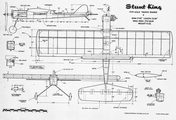 For those who are wondering just what sort of model it took to win in C/L stunt so often and convincingly in 1949, here's the plans as presented by the designer, Brian Hewitt, in the same Model Planes Annual in which the Chinn Yulon review appeared. Note the small "Booster Flap", the light wing structure, and the built-up rear fusalage. Most of the weight must have been in the engine and prop! Hewitt went on to design some quite attractive stunt models, although all small when compared to the designs being used in the USA during the same period. The Stunt King was kitted by Keil Kraft for a brief period and perhaps his 1949 success was a result of the model being too fast for the judges to see what he was doing.
For those who are wondering just what sort of model it took to win in C/L stunt so often and convincingly in 1949, here's the plans as presented by the designer, Brian Hewitt, in the same Model Planes Annual in which the Chinn Yulon review appeared. Note the small "Booster Flap", the light wing structure, and the built-up rear fusalage. Most of the weight must have been in the engine and prop! Hewitt went on to design some quite attractive stunt models, although all small when compared to the designs being used in the USA during the same period. The Stunt King was kitted by Keil Kraft for a brief period and perhaps his 1949 success was a result of the model being too fast for the judges to see what he was doing.
